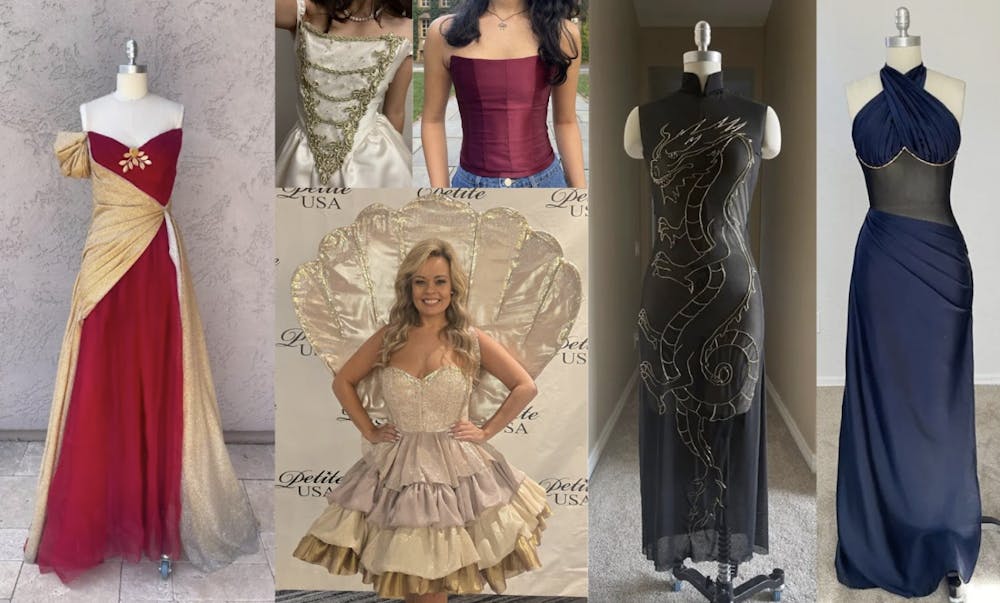Vivian Chang ’28 has run her own fashion business, sewn dozens of complicated pieces by hand, and designed for a national beauty pageant. But for the first few months of her time at Princeton, she didn’t feel comfortable being open about her interest in the field.
“I was kind of scared to tell people about it, because I think Princeton is [better] known for its STEM focus,” Chang said in an interview with The Daily Princetonian. “A part of me felt alone because I hadn’t seen anyone else do [fashion] before.”
After a video of one of her handmade corsets went viral, Chang felt more comfortable talking about her interest in fashion. Now, she’s working to create more opportunities on campus for fashion that she wished she had access to as a first-year.
Chang began exploring fashion in high school, eventually starting her own small business, Vivace Boutique, during her freshman year during the pandemic. Clients, both local and across the nation, would order custom-made French and cottage-core inspired dresses, corsets, tops, and skirts custom made from upcycled fabric. She would also make clothes for her friends, who would wear her pieces to class. When walking around with her friends and hearing them receive compliments on the piece, Chang said that it felt “so fulfilling seeing [her] work on someone else and seeing it appreciated, not only by the person using it practically, but by someone observing it on that person.”
“Fashion is like a ripple effect. It’s not just a piece of clothing that someone wears to keep themselves warm,” Chang said. “It’s also a message that you display to the outside world.”
However, at Princeton, she quickly realized that the spaces on campus for budding designers like herself were few and far between. Besides a showcase she did in her freshman spring with the Fashion Institute of Princeton, the majority of the opportunities in fashion that she found last year were of her own creation.
This past spring, Chang volunteered backstage at New York Fashion Week. There, she met a friend of the titleholder of Mrs. New England Petite, a pageant for women under 5 feet 6 inches, and showed him her portfolio of designs. He would connect her with Mrs. New England Petite, who was looking for someone to design a costume for her in the Mrs. U.S.A. Petite national competition.
“I drafted the contract, [even though] I had no idea how to draft a contract,” Chang said. She would spend a month working on the costume, which centered Mrs. New England Petite, Erin Mahoney, as the pearl in an oyster to represent her New England heritage. In Chang’s final design, Mahoney wears a corset constructed from polyester satin representing a pearl, which is then surrounded by a 3D oyster shell. Finishing off the gown, a multicolored tiered skirt drapes down from the corset to mid leg in varying gentle hues of iridescent pleats, also constructed from polyester satin.


A pearl costume.
Photo courtesy of Vivian Chang.
Chang also keeps the world up to date with her designs through @designwithvivian, an Instagram account that she started the summer before she arrived at Princeton. When asked about her proudest moment with fashion on campus, she cited a reel she posted in August of creating a corset for her friend that has since amassed over 170k views.

A red corset.
Photo courtesy of Vivian Chang.
“I didn’t think that [fashion] would be seen as cool; it was just something I liked. But I was proven very wrong by the warm reactions that I received, and it’s only motivated me to continue making videos,” Chang said.

As she enters her sophomore year, Chang’s thoughts are centered around pushing fashion into more visible spaces at Princeton. She continues to improve her design Instagram’s content, and as the managing director of The Tigress Collective, a fashion magazine club that started this year, she wants the campus to recognize just how valuable fashion can be. Specifically, she wants others to recognize that the interdisciplinary nature of fashion can offer students a previously-untapped facet to channel their intellectual and creative thought. She likens the design process to engineering, where clothing patterns become meticulously designed blueprints that the final product springs from.
“There’s a lot [of nuance] because the human body isn’t flat,” Chang said. “There [are] a lot of curves and a lot of darts that you have to account for to make sure that the final 3D product fits your body.” That requires planning out the math, geometry, aerodynamics, and “how the textile will behave based on where the grain line is facing or … when heat is applied,” she said.
Chang points out that Princeton doesn’t offer any dedicated classes on fashion.
“I think it’s like a feedback loop,” she said, arguing that students have to publicly demonstrate interest for the opportunity.
“I think there also needs to be an initiative from … the academic administration of the school to provide these opportunities for students,” she said. “And through those two things combining together, I think, is what will change the culture on campus from not really caring about fashion to seeing it as a legitimate, professional, and respectable pursuit.”
Leia Pei is a contributing writer for The Prospect. She is a member of the Class of 2029, and can be reached at lp2943[at]princeton.edu.
Please send any corrections to corrections[at]dailyprincetonian.com.








